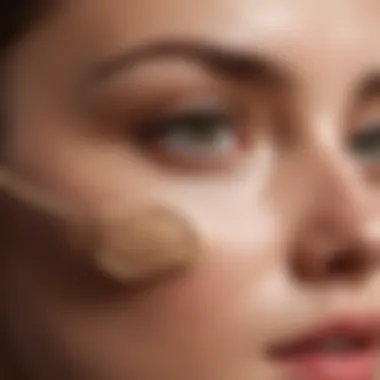Exploring the Best Foundation Primers for Flawless Makeup


Intro
In the realm of makeup, foundation carries significant weight. It sets the tone for your look, ensuring a seamless base for other products to follow. However, achieving a flawless finish often calls for an unsung hero in the makeup application process: the foundation primer. This article delves deep into the world of foundation primers, illuminating their crucial role in enhancing the overall aesthetic of one's makeup.
Primers are not merely an optional step but rather a fundamental part of the makeup routine, especially for those striving for an impeccable look. They help in creating a smooth canvas, allowing your foundation to glide effortlessly and adhere effectively. Additionally, they can address specific skin concerns, whether it be excess oil, dryness, or redness.
Understanding the diversity of primers available on the market is essential. There are various formulas tailored to different skin types and preferences. This guide aims to equip beauty enthusiasts, particularly women aged 18 to 45, with the insights necessary to make informed choices when it comes to selecting the right foundation primer.
Throughout this exploration, we will cover the significance of choosing the correct product, the latest trends in primers, and provide you with practical beauty tips to enhance your makeup routine. With these valuable insights, you will be prepared to elevate your makeup game and achieve a flawless finish.
Understanding Foundation Primers
Foundation primers are vital tools in the makeup application process. They serve to create an ideal canvas on which foundation can be applied, improving both the overall appearance and longevity of makeup. By understanding the importance of foundation primers, beauty enthusiasts can elevate their makeup techniques.
What Is a Foundation Primer?
A foundation primer is a cosmetic product applied before foundation to enhance the makeup application. Primers come in various formulas and consistencies, designed to address specific skin concerns. Their primary purpose is to create a barrier between the skin and makeup, ensuring a smoother application.
Using a primer can significantly improve the results of makeup products. There are many options on the market, each formulated for different skin types. Typically, a primer is silicone-based, water-based, or a combination of both. Applying a thin layer allows the foundation to adhere better, providing a flawless finish.
The Role of Primers in Makeup Application
Primers play a crucial role in the makeup application process. They provide several benefits that enhance the overall look and feel of makeup. Here are a few key functions:
- Smooth Surface: Primers fill in fine lines, pores, and uneven textures on the skin. This creates a smooth surface for the foundation, resulting in better application and overall appearance.
- Extended Wear: A good primer increases the longevity of makeup. It helps foundations stay in place all day, minimizing the need for touch-ups.
- Improved Finish: The right primer can enhance the finish of foundation. Whether radiant, matte, or satin, the choice of primer can influence the final look.
"Using a primer can dramatically enhance your foundation's performance and help it last longer throughout the day."
- Oil Control: For those with oily skin, primers can help control shine and oil production, preventing makeup from sliding off.
- Hydration: Hydrating primers can provide moisture to dry skin, creating a balanced base.
Types of Foundation Primers
Understanding the different types of foundation primers is crucial for anyone looking to achieve an impeccable makeup finish. Each primer formulation serves a distinct purpose and caters to varying skin needs. By familiarizing oneself with the types available, users can select the most suitable option that enhances their foundation application and overall look. The choice of primer can significantly impact makeup longevity and skin appearance, making this topic essential for beauty enthusiasts.
Silicone-Based Primers
Silicone-based primers are known for their smooth texture and ability to create a flawless canvas. These primers often contain ingredients like dimethicone or cyclopentasiloxane, which help to fill in imperfections and fine lines. The primary benefit of silicone-based primers is their ability to reduce the appearance of pores and provide a soft-focus effect.
Silicone primers can make the skin feel velvety smooth and improve the way makeup adheres to the skin.
These primers are typically suitable for normal to dry skin types. However, those with oily skin may find them too heavy, potentially leading to breakouts. Therefore, it’s important to test the primer and monitor the skin’s reaction after use.
Water-Based Primers
Water-based primers are often lighter than their silicone counterparts. They contain a high percentage of water as their primary ingredient, making them ideal for those with oily or combination skin. Water-based formulas can provide hydration without the heaviness that some users may wish to avoid. These primers allow the skin to breathe while providing a thin layer of coverage.
These types of primers are great for makeup wearers who prefer a more natural look. If makeup products are labeled as "water-resistant," using a water-based primer can help maintain the appearance throughout the day. Users should check the ingredient list, especially for any skin concerns they might have.
Matte Primers
Matte primers are specifically designed for those who deal with excess oil and shine. They typically contain oil-absorbing ingredients that help reduce greasiness and deliver a matte finish. These primers are perfect for wearers during hot or humid weather conditions, as they can help keep the makeup in place. Users who often face the challenge of oily skin will find significant benefits from using a matte primer.


It’s essential to apply a small amount to avoid a heavy texture, which can interfere with makeup application. For the best results, pair matte primers with similarly formulated foundations for a long-lasting finish.
Hydrating Primers
Conversely, hydrating primers focus on providing moisture to the skin before makeup application. These primers generally contain ingredients like glycerin or hyaluronic acid, which help to keep the skin moisturized throughout the day. They are particularly beneficial for individuals with dry or dehydrated skin, allowing for a radiant and glowing makeup look.
Hydrating primers can contribute to a more comfortable wear, reducing the tightness or dryness some may experience with regular foundation. It’s crucial for users to choose a hydrating primer appropriate for their skin concerns, as every individual’s needs are unique.
Color-Correcting Primers
Color-correcting primers offer targeted solutions to specific skin issues. These primers come in various shades, each designed to counteract different skin concerns. For instance, a green primer can neutralize redness, while a lavender one can brighten dull complexions. Using a color-correcting primer can significantly improve the overall appearance of the skin by minimizing imperfections before foundation is even applied.
Choosing the right shade is essential. It can be beneficial to consult with a beauty expert or to test options to see which color aligns with one’s skin tone and concerns. An informed selection can provide a significant barrier to harsh colors and uneven application in the makeup routine.
In summary, understanding the different types of foundation primers is imperative for anyone invested in their makeup application. Each primer type has benefits tailored to diverse skin needs, allowing users to maximize their makeup’s potential.
Key Benefits of Using a Foundation Primer
Foundation primers play a pivotal role in the makeup application process. They are essential for achieving a polished and long-lasting look. Each benefit a foundation primer offers addresses specific concerns many individuals face with makeup wear. By understanding these advantages, beauty enthusiasts can make informed decisions when selecting primers suitable for their needs.
Enhancing Makeup Longevity
One of the primary benefits of using a foundation primer is its ability to boost the longevity of makeup. A well-chosen primer creates a barrier between the skin and foundation. This barrier helps prevent the foundation from fading, settling into fine lines, or disappearing over time. As a result, using a foundation primer can extend the wear of makeup by hours, allowing individuals to maintain their look throughout the day or night.
Expert tip: Look for primers labeled as long-lasting or wear-optimizing. These often contain special polymers or ingredients designed to lock in color and provide durability.
"Foundation primers not only enhance appearance; they also increase the lifespan of your makeup, making your investment worthwhile."
Smoothing Skin Texture
Another significant benefit is the smoothing effect foundation primers have on the skin's texture. Many high-quality primers are formulated with silicones or soothing agents that fill in fine lines and even out skin surface irregularities. This results in a more uniform canvas for foundation application. A smooth surface allows the foundation to glide on effortlessly, minimizing the effort needed to achieve a flawless look.
For individuals with blemishes or uneven skin texture, a smoothing primer can significantly improve the finish of their makeup. It transforms the surface, promoting an airbrushed effect when foundation is applied.
Minimizing the Appearance of Pores
Primers also excel at minimizing the appearance of pores. Many people find enlarged pores can detract from their makeup look. A well-formulated primer often contains specific ingredients like micro-particles that create an optical illusion, blurring the appearance of pores. This is particularly beneficial for those with oily or combination skin, where pore visibility may be more pronounced.
Selecting a primer that specifically targets pore reduction can transform how foundation sits on the skin, resulting in more flattering coverage.
Controlling Oil and Shine
For individuals prone to oily skin, foundation primers can provide valuable oil control. Many primers designed for oily skin contain mattifying agents that absorb excess sebum throughout the day. This helps maintain a shine-free complexion, ensuring makeup remains fresh and even.
Applying a mattifying primer can also create a smooth surface, allowing foundation to adhere better and reducing the chances of makeup slipping off due to oil buildup.
Choosing the Right Foundation Primer for Your Skin Type
Selecting the appropriate foundation primer for one’s skin type is crucial for achieving a flawless makeup application. Each skin type has distinct needs, and recognizing these needs can significantly impact the overall look and longevity of makeup. The right primer can enhance the skin's texture, improve makeup adherence, and help tackle specific concerns such as oiliness or dryness. By choosing a primer formulated for your skin type, you can optimize your beauty routine and achieve the best results.
For Oily Skin
Individuals with oily skin often struggle with excess sebum production, which can lead to makeup sliding off or becoming patchy through the day. For this skin type, silicone-based primers are particularly beneficial as they create a barrier that controls oil and shine. These primers usually have a matte finish and can minimize the appearance of pores, leading to a smoother surface for foundation application. Look for keywords such as "oil-free" and "mattifying" on the product label. Avoid heavy, greasy formulations that can exacerbate shine and clog pores.


For Dry Skin
Dry skin requires special attention when selecting a foundation primer. Hydrating primers that contain ingredients like hyaluronic acid or glycerin are ideal. These ingredients help retain moisture and create a plump base, allowing foundation to glide evenly across the skin. It is important to steer clear of mattifying primers as they can exacerbate dryness. Instead, opt for primers that promise hydration to ensure that your foundation looks fresh and dewy rather than cakey.
For Combination Skin
Combination skin exhibits characteristics of both oily and dry skin, necessitating a balanced approach when choosing a foundation primer. A good option would be a primer that is lightweight and provides hydration where needed while controlling shine in the T-zone. Look for products labeled as "balancing" or "multi-tasking." These formulations typically offer a blend of hydrating ingredients and oil-absorbing properties, making them suitable for areas with varying needs.
For Sensitive Skin
Sensitive skin demands a gentle approach. Factors such as redness, irritation, or allergies need to be taken into account when choosing a foundation primer. Look for primers that are fragrance-free and hypoallergenic. Products containing soothing ingredients like aloe vera or chamomile may be beneficial. Avoid alcohol-based primers as they can lead to further irritation. A light, moisturizing primer can act as both a protective barrier and provide a smooth base for foundation without aggravating the skin.
Choosing the right primer tailored to your skin type can transform your makeup application, offering both comfort and a flawless finish.
How to Apply Foundation Primer Effectively
Applying foundation primer correctly is crucial as it sets the stage for your makeup. A well-applied primer can significantly enhance the overall look of your makeup and ensure that it lasts throughout the day. This section covers key steps that are vital in achieving the desired results. Understanding the process can transform your makeup routine, enabling you to create a smoother canvas for foundation and other products.
Preparation of the Skin
Before applying foundation primer, it is essential to prepare your skin. This step is often overlooked but is critical for achieving a flawless finish. Start by cleansing your face to remove any excess oil or residue. A clean surface allows the primer to adhere better.
Next, consider exfoliating if your skin feels rough or has dry patches. Gently scrubbing away dead skin cells creates a smoother surface. After exfoliating, apply a suitable moisturizer. Hydrated skin will help the primer spread evenly.
Additionally, if you have time, allowing your moisturizer to absorb fully before applying primer is crucial. Aim for at least five to ten minutes. This waiting period helps in creating a seamless application.
Application Techniques
When it comes to applying foundation primer, technique matters. Begin by dispensing a small amount of primer onto your fingertips or the back of your hand. Using your fingers will provide a warm application, but you can also use a brush or beauty sponge.
- Dotting Method: Place small dots of primer on the center of your forehead, cheeks, and chin. Then, gently blend it outward towards your hairline and jawline. This method ensures an even distribution.
- Smooth Application: For oilier areas like the T-zone, apply a little extra product. This will control shine better. Use broad strokes to smooth the primer into the skin.
- Allow Time to Set: After applying, give the primer a moment to set. This waiting period can be anywhere from one to three minutes. Allowing it to dry will help it form a better bond with the foundation.
Using the right application technique enhances makeup longevity and the overall look.
Layering with Other Skincare Products
Layering your primer with other skincare products can be beneficial. It’s essential to choose complementary products. Avoid heavy creams and opt for lighter textures to prevent makeup from sliding off. Here’s how to effectively layer:
- Serums: Apply serums before your primer. These products often have beneficial ingredients that can improve skin's appearance.
- Sunscreen: If you use sunscreen, apply it first. Ensure it has fully dried before proceeding with the primer.
- Moisturizer: As previously mentioned, using a lightweight moisturizer is advisable. Heavy creams can interfere with the primer's effectiveness.
In summary, preparing the skin, mastering application techniques, and experiencing the benefits of layering can drastically improve your makeup's quality. Understanding these processes can elevate the effectiveness of your foundation primer, leading to an enhanced makeup experience.
Popular Foundation Primers in the Market
In the world of beauty, selecting the right foundation primer plays a crucial role in achieving an ideal makeup finish. This section will address popular foundation primers in the market, focusing on their unique attributes, advantages, and what makes them stand out. Understanding these options allows beauty enthusiasts to make informed choices and elevate their makeup routine.
High-End Options
High-end foundation primers often come with advanced formulations and targeted benefits. They tend to include premium ingredients that not only prepare the skin for makeup but also offer skincare properties. Brands like Smashbox and Hourglass are known for their luxurious primers that cater to various skin concerns.
One of the notable high-end options is the Smashbox Photo Finish Foundation Primer. This product minimizes the appearance of pores and fine lines, providing a smooth canvas for foundation application. Another favorite is the Hourglass Veil Mineral Primer, which is particularly effective for oil control and offers SPF protection.


These high-end primers often justify their price tag by delivering superior performance and complementary skincare benefits. Users may find their makeup enduring longer and appearing more flawless compared to drugstore alternatives.
Drugstore Picks
Drugstore foundation primers have gained a reputation for delivering quality at a more accessible price point. One popular choice is the e.l.f. Poreless Putty Primer, which offers a lightweight formula that helps fill pores and creates a smooth base for foundation. Similarly, Maybelline’s Baby Skin Instant Pore Eraser is celebrated for its ability to blur imperfections while remaining budget-friendly.
These drugstore options often provide good performance without the financial commitment associated with high-end brands. Beauty enthusiasts on a budget can achieve impressive results with these products, proving that effective primers need not break the bank.
"Selecting the right foundation primer is not just about price; it’s about finding what suits your skin’s unique needs and how the product interacts with your makeup."
Mistakes to Avoid When Using Foundation Primer
Using foundation primer correctly is essential for achieving a flawless makeup application. However, certain mistakes can undermine its effectiveness and lead to unsatisfactory results. Understanding what these mistakes are can dramatically enhance your makeup routine. This section will detail two significant errors to avoid when using foundation primer: overusing the product and neglecting skin type considerations.
Overusing Product
One of the most common mistakes beauty enthusiasts make is overusing foundation primer. Applying too much product can create a heavy, greasy feel on the skin, which contradicts the purpose of a primer. A small amount is typically sufficient to achieve the desired effect.
Why is it important to avoid overuse?
- Wasting Product: When you apply more than needed, you waste valuable product and money. Primers are designed to create a smooth base with just a thin layer.
- Impact on Makeup: An excessive layer can lead to makeup sliding off throughout the day, reducing its longevity. This makes the primer counterproductive.
Tips for proper application:
- Start with a pea-sized amount on your fingertips.
- Dot it on key areas, such as the cheeks, forehead, and chin.
- Blend it out gently, ensuring an even layer without excess product.
Neglecting Skin Type Considerations
Another critical mistake is failing to consider your skin type when selecting a foundation primer. Using a primer incompatible with your skin’s needs can lead to various issues, including breakouts or an uneven finish.
- For oily skin: A mattifying primer is preferable as it helps control shine and provides a longer-lasting makeup application.
- For dry skin: A hydrating primer is more suitable as it prevents flakiness and creates a smooth base.
- For sensitive skin: Choose a primer with gentle formulations to avoid irritation.
How to select the right primer:
- Assess your individual skin concerns.
- Look for products labeled specifically for your skin type.
- Test different formulas, if possible, to see how your skin reacts.
"The right foundation primer can elevate any look, while the wrong choice can sabotage even the best makeup techniques."
By avoiding these two common mistakes—overusing the product and neglecting skin type considerations—you can enhance your makeup application significantly. Understanding these elements will improve your foundation experience and help you achieve the flawless results you desire.
Ending
In the realm of makeup, the significance of foundation primers cannot be overstated. This article has thoroughly explored their role, variances, and the benefits they offer. As a bridge between skincare and makeup, foundation primers serve not only to prepare the skin but also to enhance the overall makeup experience. They play a pivotal role in ensuring that the foundation applies smoothly and lasts longer. Additionally, understanding how to choose the right primer tailored to individual skin types can profoundly influence the final makeup effect.
Recap of Foundation Primer Benefits
Foundation primers bring various benefits to the makeup application process. Here’s a brief recap:
- Enhanced Longevity: By creating a smooth canvas, primers help to make foundation last longer throughout the day.
- Smoother Texture: Primers help in filling fine lines and uneven skin surfaces, leading to a flawless finish.
- Minimized Pores: Many primers are formulated to reduce the appearance of pores, promoting a more even look.
- Oil Control: They can effectively manage shine in oily areas, ensuring that your makeup does not break down too quickly.
- Hydration and Skin Care: Certain primers include ingredients that moisturize the skin, adding an extra layer of care.
These advantages make foundation primers an indispensable part of many beauty routines. They prepare the skin, allowing other makeup products to perform at their best.
Encouragement to Experiment with Choices
As every person's skin is unique, it is vital to approach foundation primers with an experimental mindset. Trying different types of primers can lead to discovering what works best for your skin type. Whether you might benefit from a silicone-based formula or a hydrating option, there is a primer for everyone.
- Test Various Brands: Not all primers perform alike. Different brands offer distinct formulations that might better suit your needs.
- Mix and Match: Some beauty enthusiasts have found success in combining different types of primers. This approach can address multiple skin concerns at once.
- Stay Updated: The beauty industry continually evolves, with exciting innovations and new products emerging regularly. Keeping an eye on reviews and recommendations can provide fresh options.
By embracing the variety of foundation primers available, you give yourself the opportunity to achieve an ideal makeup look that enhances your natural beauty.



